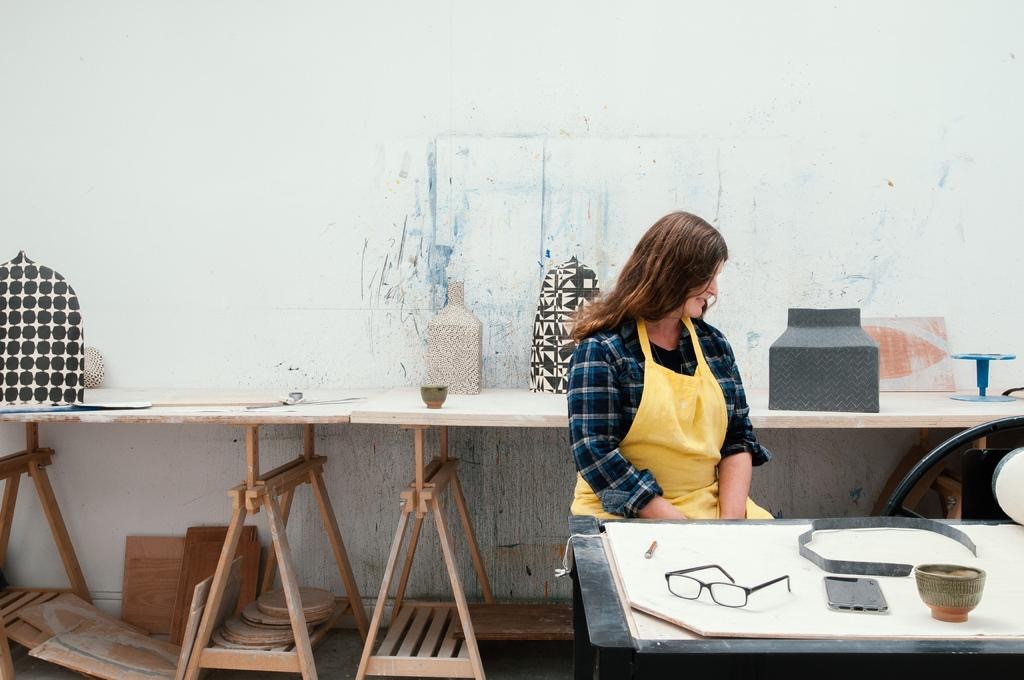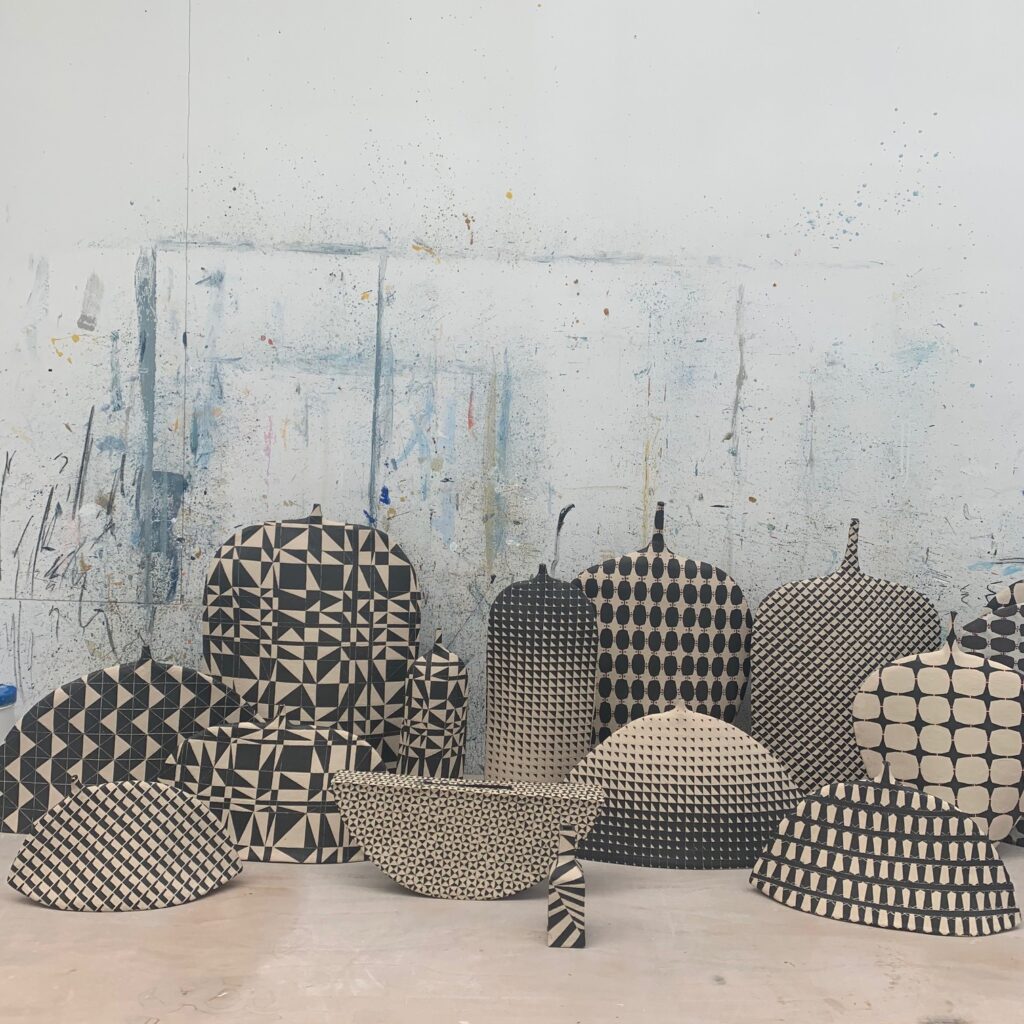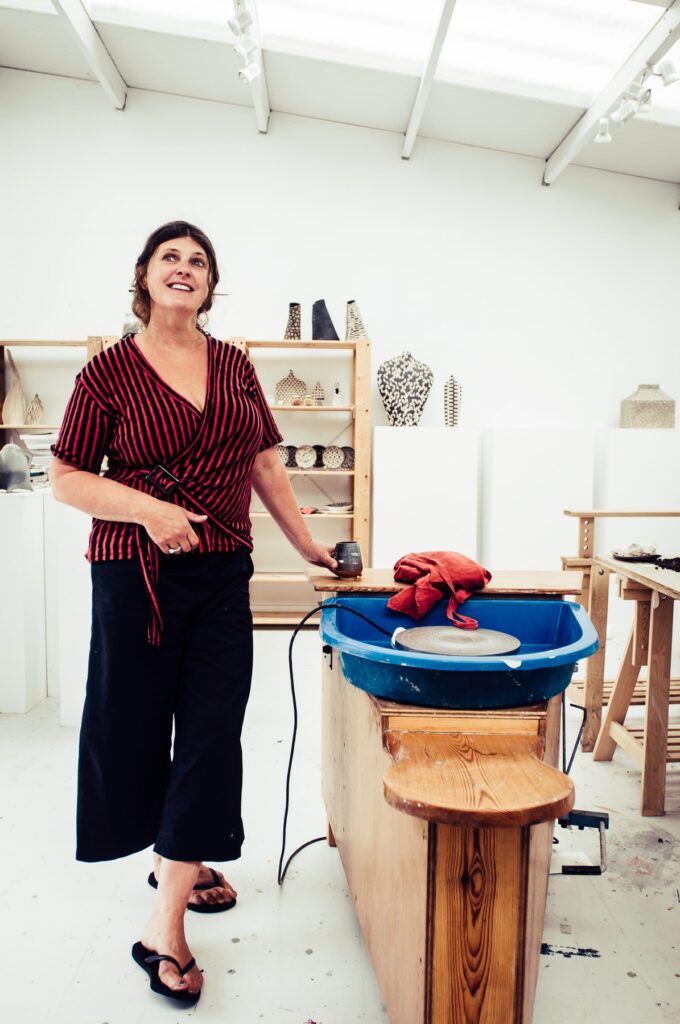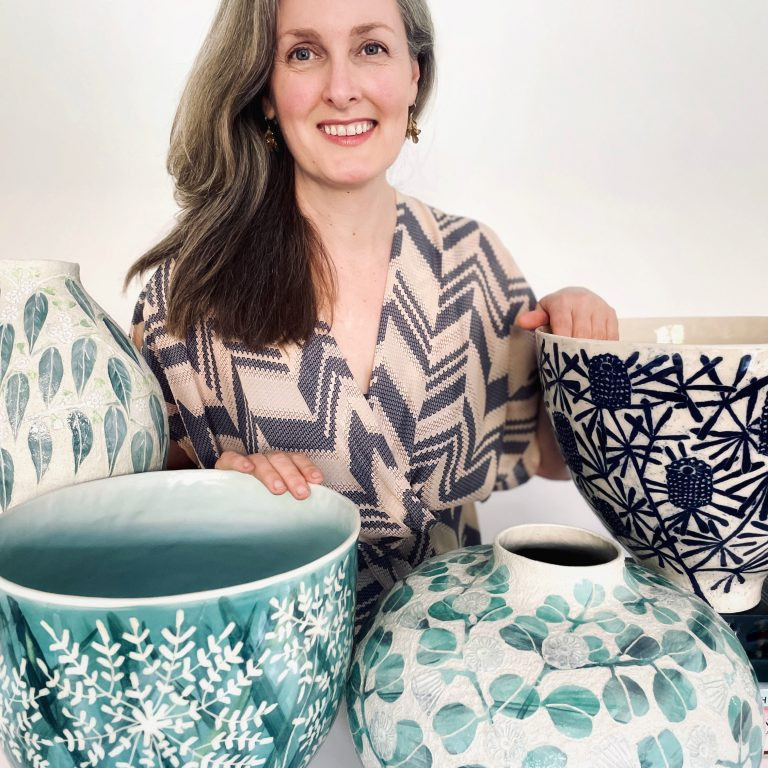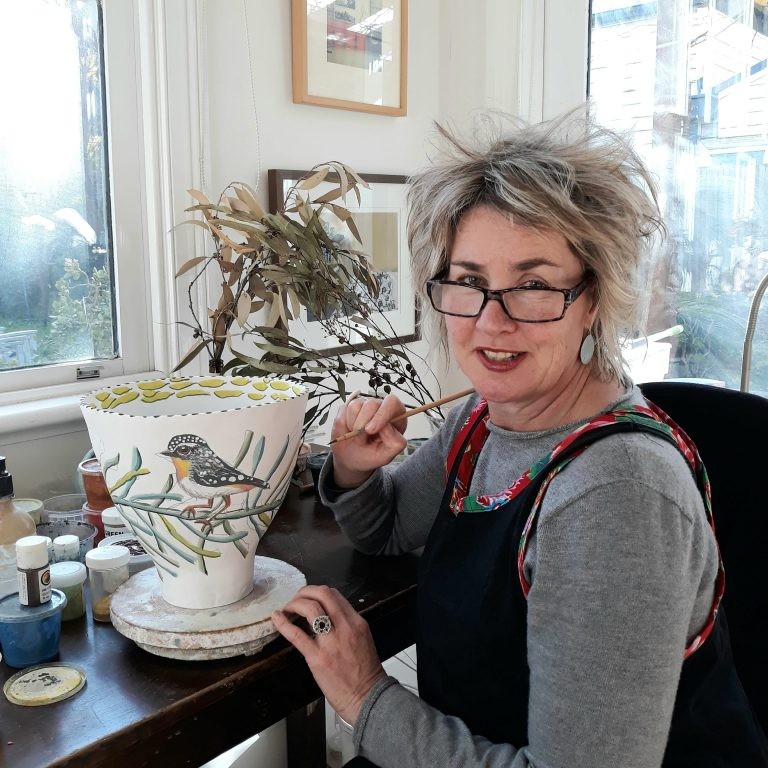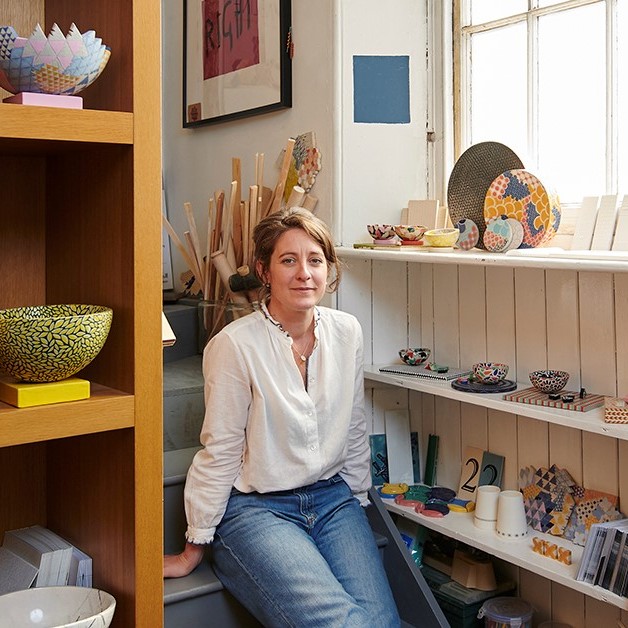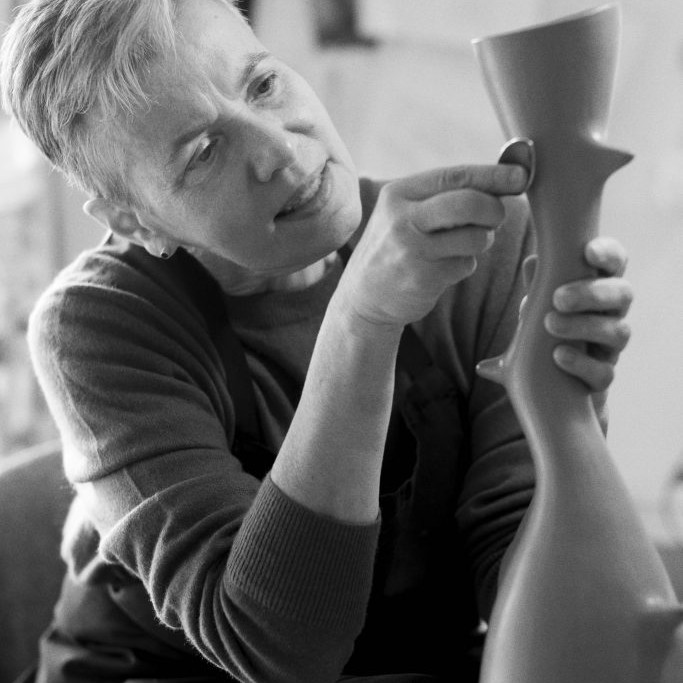Björk Haraldsdóttir Ceramic Artist
How has your architectural training influenced your ceramic work?
My background in Architecture is naturally a strong influence on my work. Training to become an Architect is a rigorous process and takes 7 years, and then also a lifetime. I have now worked with clay longer than training to be an Architect. I still plan and draw my pieces before they are made like an Architect will do, and feel and adapt the work as it is constructed like an artist.
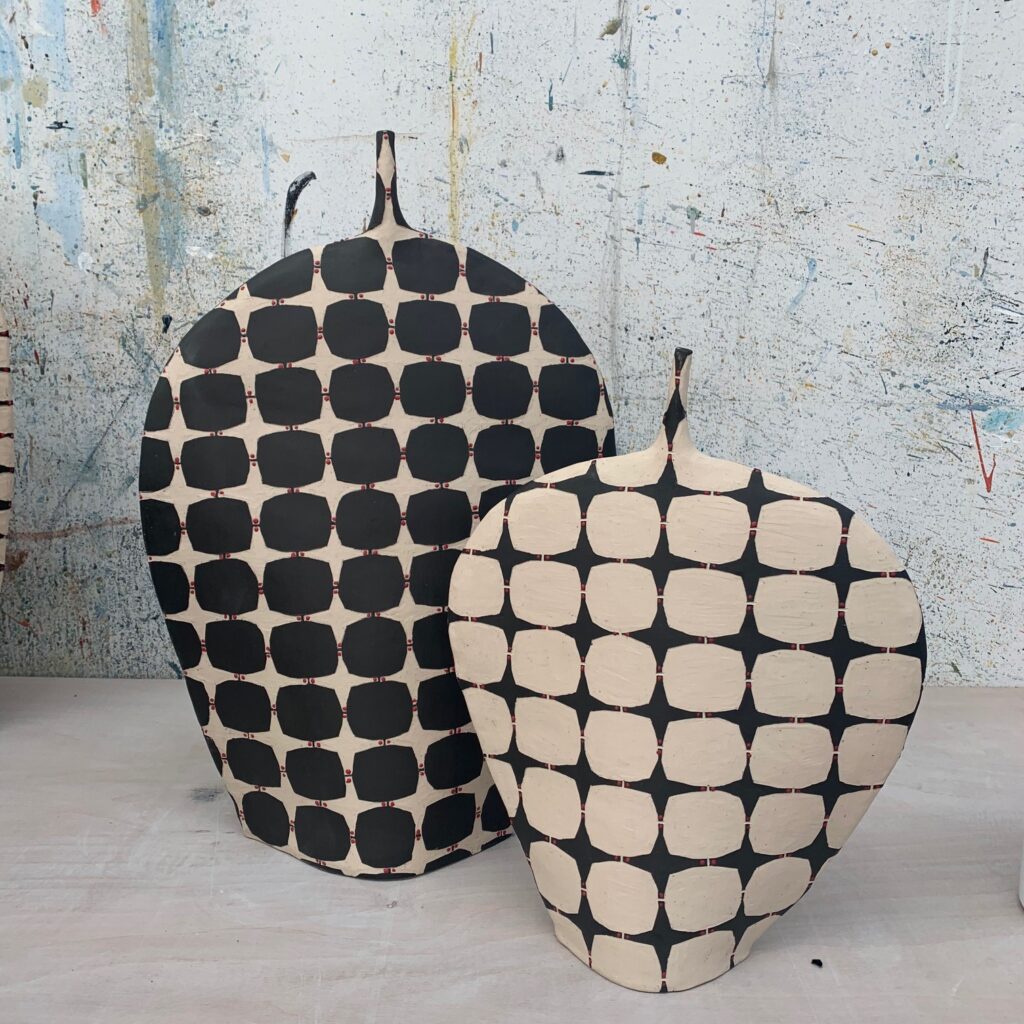
Tapestry #10.1 52cm x 34 cm Tapestry #10.2 48 cm x 31 cm
As both an architect and ceramic artists, in your opinion how are both used to enhance each other?
I liken my work to small architecture with no brief and no client. Producing un-commissioned artwork strips away the burden of those constraints to leave only the creative act, a liberating situation and an issue that I am not complacent about. The technical skills you learn as an Architect are invaluable to me. It influences how I construct my work since it is not really a skill I learned in my ceramic training. The pattern of the ceramics is like the façade of a building- both are integral to the design.
What led you from architecture to ceramics?
I first started making ceramics as an antidote to the creative chains of practicing Architecture; Architecture is a complex multi-faceted professional endeavour that is constrained by a vast array of technical and legislative issues. Clay is freedom.
A group of 2020 pots
Can you discuss the sizes of your ceramics?
The scale of my work is basically limited by the height of a large top-loading electric kiln. Ordinarily my work is of the largest size I can manage (upto around 65cm high) because the pattern repeats tend to be more effective across larger surfaces.
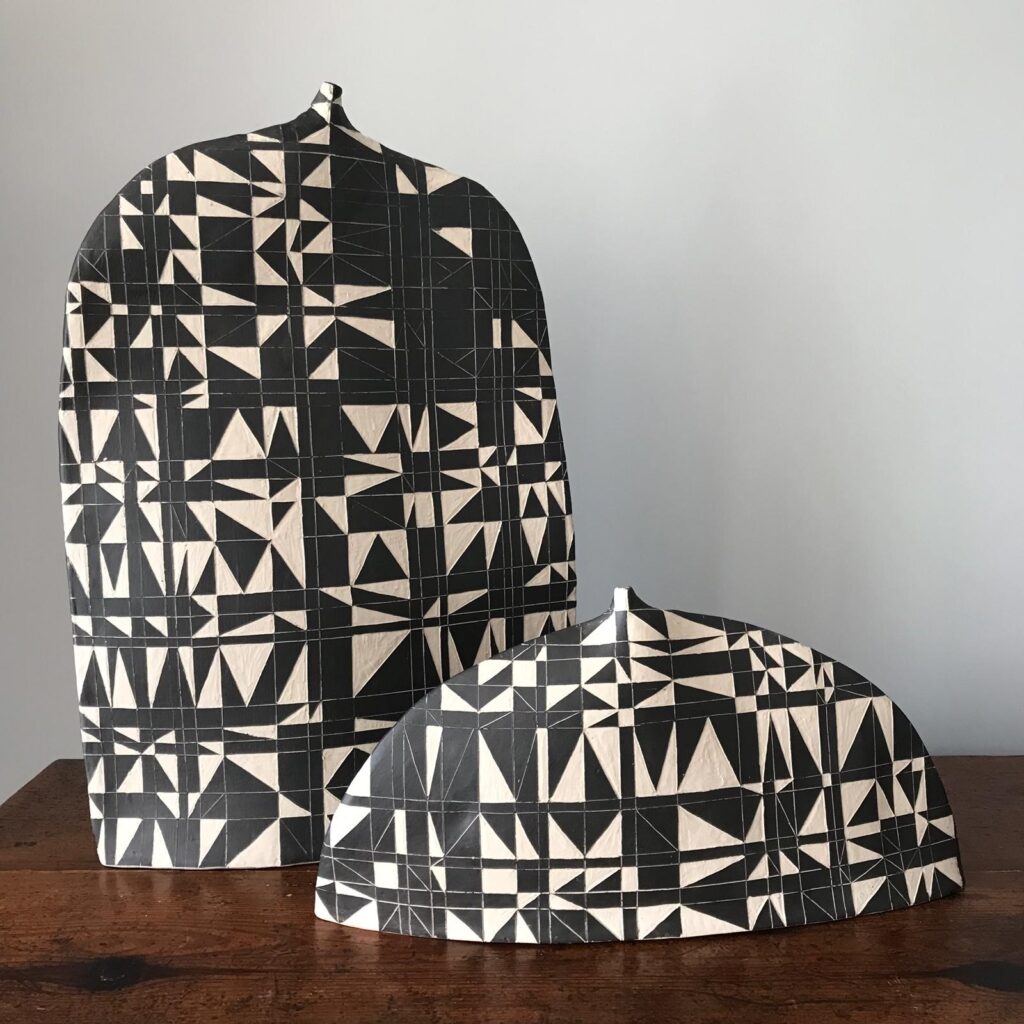
Hamar I (back, 58 cm x 37 cm ) and Hamar II 28 cm x 38 cm). Photograph by Cavaliero Finn
I try to engender the appearance of a patterned cloth draped over the clay form which is generally successful using either geometric or random repeats. During the recent lockdown and with the cancellation of all planned exhibitions artist Matthew Burrows came up with the brilliant #artistsupportpledge, an initiative based around the sale of ‘affordable’ artworks on Instagram. This led me to working at a much smaller scale than I had previously and allowed my work to progress in slightly different direction. My pieces have always worked well in groups, but on the smaller scale it has a particular dynamic and I have been producing sets of two and three ‘companion’ pieces. The patterns do sometimes need to be significantly scaled-down on each piece to succeed but when placed in series an interesting relationship between pattern and form begins to emerge.
Pattern is a major component of your art, discuss your thoughts on pattern and shape in your work.
I started my ‘pattern journey’ referencing to old textile work and stitching patterns from Iceland and Nordic Culture. This has developed over time into patterns inspired by ideas and images I come across in nature and daily life. I am constantly working into the pieces ‘making stitches’ or lines of weave and the result is often cloth-like in appearance.
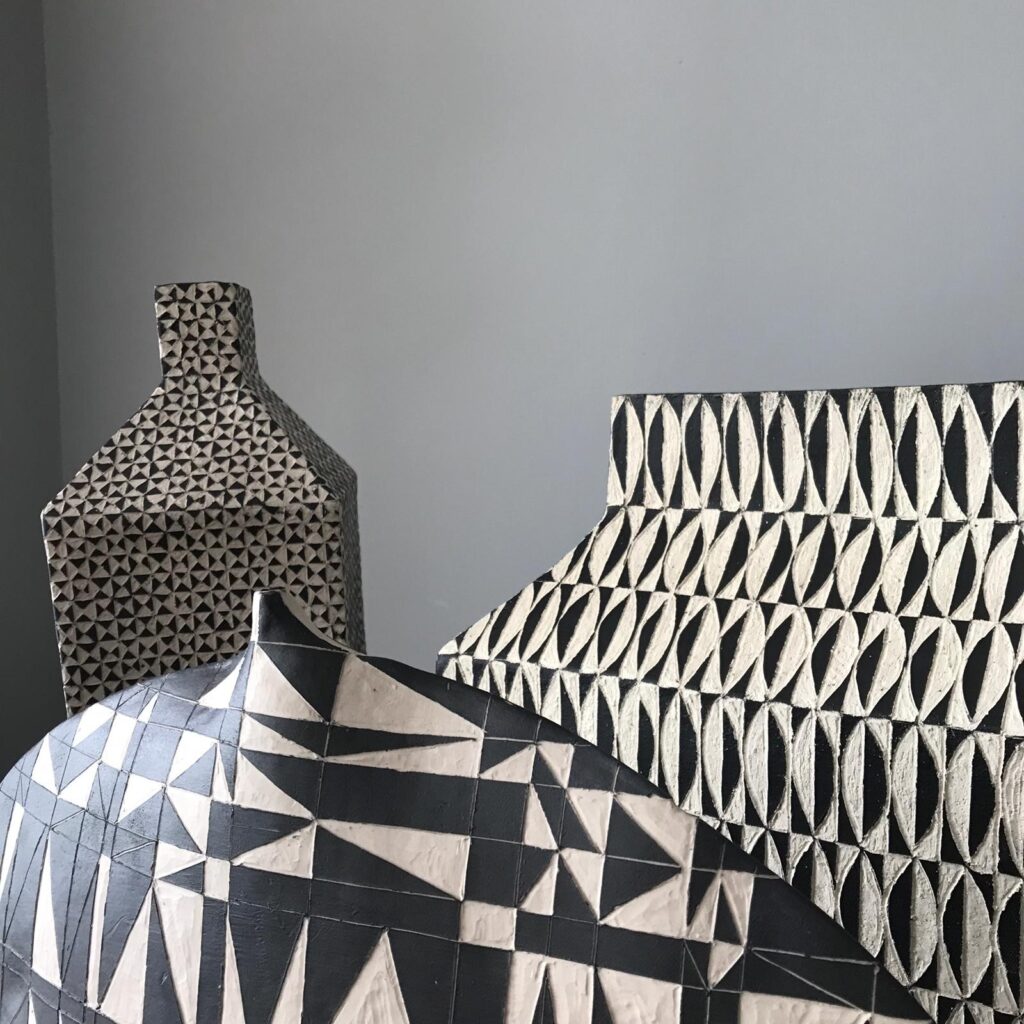
Hamar II (front, 28 cm x 38 cm), Hejduk I (back right, 32 cm x 36cm x 20 cm,). Hejduk II (back left, 37cm x 22 cm x 22 cm ). Photograph by Cavaliero Finn
Form and pattern are individually and equally important and my work is defined by the interaction of these very distinct attributes. There is an ambiguity in the pieces with the pattern acting to disguise the shape of the vessel as it runs seamlessly across creases and corners. Shape and pattern are usually conceived in a planned design, however I have become more flexible over time and now often build the form and assess it before committing to pattern. I like to place a rigid, geometric pattern onto an organic form – a bottle or bell shape. The pattern type significantly alters the perception of a piece’s geometry any given base shape will appear dramatically different when rendered with alternative patterns.
Is all of your work black and white?
I have always been drawn to black and white (or dark and light) and how the monochromatic palette can differ so much. I do create some work with third colour highlights which is effective in accentuating three dimensional illusion and setting up another narrative. I also often line internal surfaces at openings such as the neck of bottle shapes, which begin to suggest a hidden organic interior.
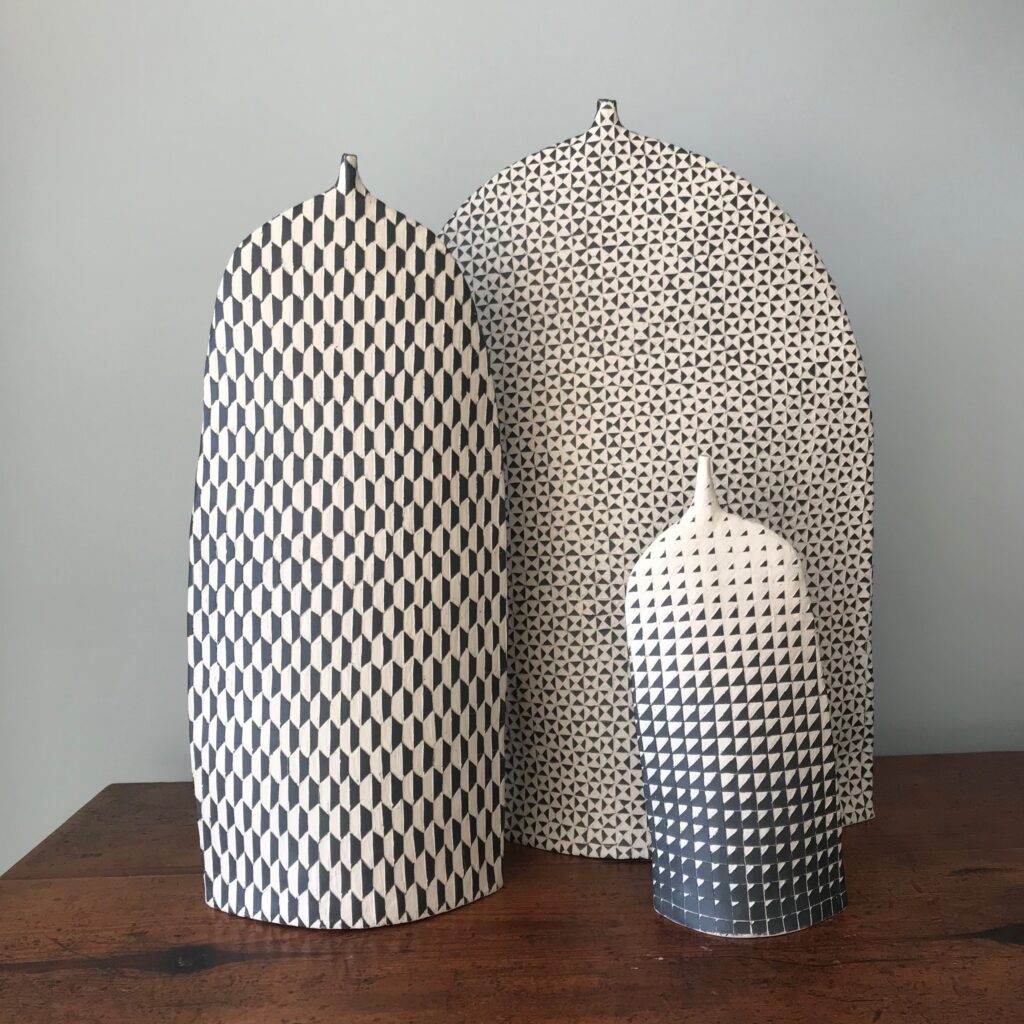
Poem (58cm x 41 cm , back) , Basalt (52cm x 24 cm, front left) , Horizon III ( 31cm x 15 cm, Front right). Photograph by Cavaliero Finn
Discuss the technique of hand building ceramics and why you use this technique?
Hand-building with slabs, which is the process I manly use, is like putting together a mini building. The detail is important, the joining of the slabs and the finishing of the form. It goes hand in hand with my training. I know how to make a pot stand up and I also know if I take shortcuts it is likely to collapse or crack in the kiln. The end result of a piece sets up a visual conversation between the pseudo -perfection of geometric pattern and the tactile impurity of hand-manipulated clay.
Do you make specific works to be bought in groups?
I think strong motifs often sit well together, particularly patterns of different grains. I do not always pre-plan works in pairs or groups but rather experiment with combinations to find successful companion groups. It is sometimes the least expected combinations that work best.
Discuss the design element on your work Ebb and Flow.
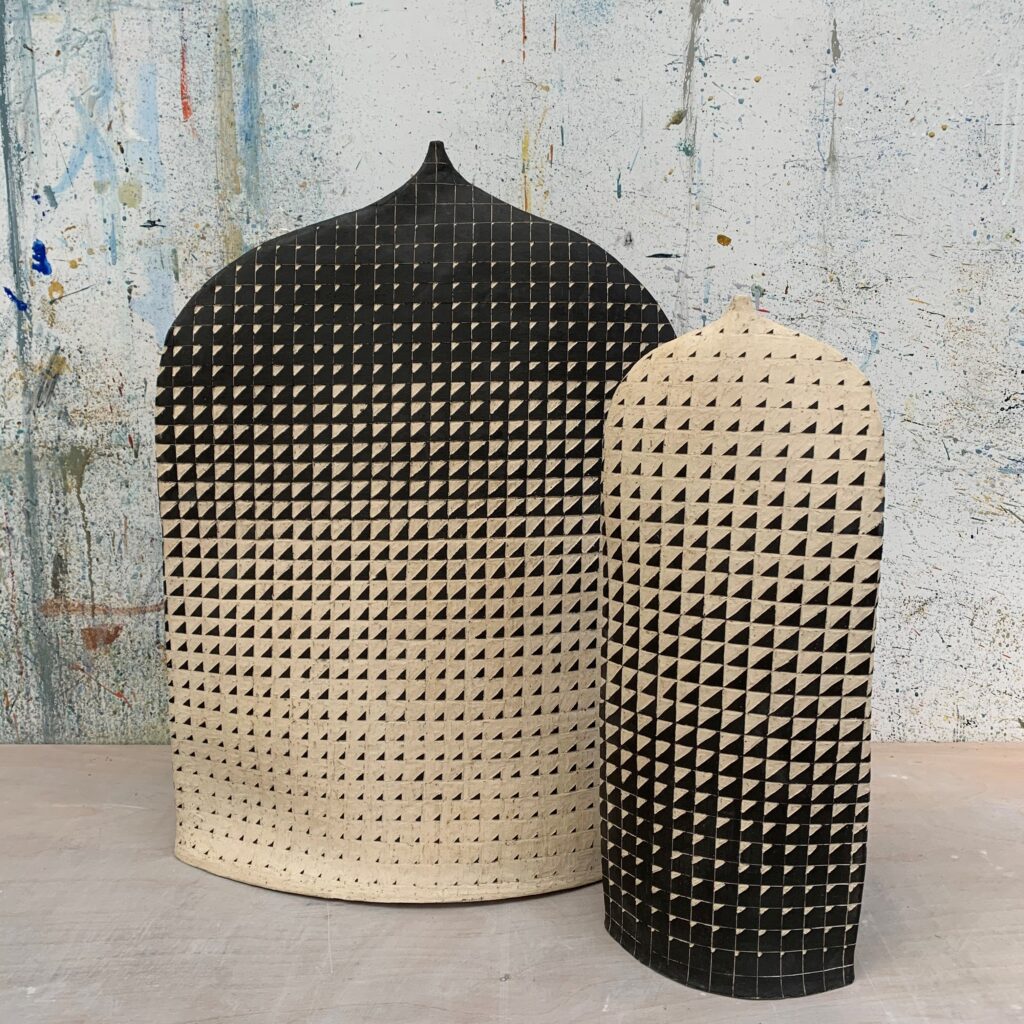
Horizon I (60 cm x 47 cm), Horizon II (52 cm x 27 cm, front)
Ebb and Flow was shown as a part of a show for London Art Fair curated by Cavaliero Finn and setting my work with reciprocal pieces by textile artist Jacy Wall.
The two pieces are a pair of similar vessels with inverted patterns fading vertically across the surface. The name Ebb and Flow describes the transition of the pattern from black to white to black and vice versa reflecting the ebb and flow of the tide on the shoreline..
Comment on the importance of good photography for the presentation of your work.
Certainly a considered context is important for photographing art. I work in a studio previously inhabited by the abstract landscape painter Boo Mallinson and most of my work is photographed against the backdrop of the her paint spatters, like a Jackson Pollock mural!. This sets an active scene and avoids the sterility of a white box gallery still.
Do you keep a sketch book that you work your patterns and design ideas in?
Yes, it is important for me to keep a record of my designs and plans for new designs. There is always something new that comes from each sketch.

Patterns. Photo by Cavaliero Finn
How has the pandemic effected your art and art practice?
It has, actually had an unexpectedly positive effect despite the cancellation of nearly all planned gallery exhibitions. I kept working through but rather than building up a collection for future exhibitions as expected I have not been able to work fast enough to meet the demand for smaller works sold online. It has not altered the expression of the work itself – pattern is virus resistant.
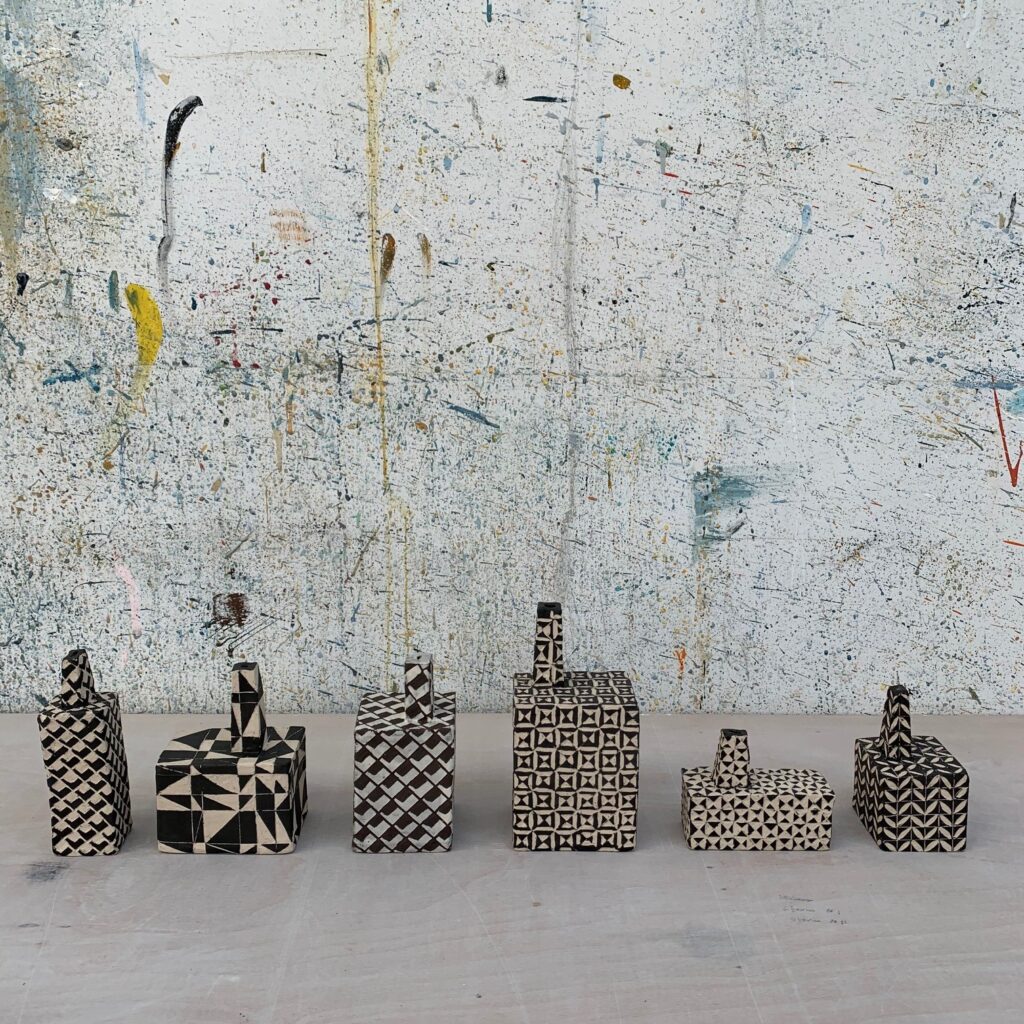
Vernacular series. Small pots ranging in height from approximately 6-12 cm, created for #artistsupportpledge.
Can you briefly discuss the technique you use to create your patterns on your work.
To create the patterns successfully the state of the clay is very important -it needs to be just less than leather hard. I paint the whole surface of each pot with black or white slip dependant on the clay used and when the slip has lost its sheen, score the pattern outline into the slip using paper strips and pencil. When the slip has hardened slightly more I scrape away sections of slip to reveal the clay beneath. The process is very laborious and I have to be careful to keep the pots well wrapped and humid between sessions so that the pattern can be completed over several days.
Do you have your own studio? Where is it?
My studio is in the south west of England in my West Dorset garden. It is essential for the studio to be close to my house due to the process of working with slip in the way I do – I need to be able to quickly cover or uncover the work at various stages of the drying process.
What are two aspects that you love about the studio?
The outlook from the studio is fantastic with long views over the Devon countryside and great sunsets most evenings. I also appreciate a studio that is large enough to cope with the mess a ceramic studio often demands. It’s a good place to not be an Architect.
What is the most recent purchase that you have made for your studio and why?
I recently bought a new large slab roller. My pots are so large and having to roll out very large slabs from clay is extremely physically demanding. Having a slab roller has literally transformed my life.
How does your environment influence your work?
I am sure the extraordinary nature in my native Iceland creeps in but it is possibly more my immediate family who now influence my work. We are an artistic family of Architect (my partner), photographer (my 18 year old son) and GCSE Art Scholar (my 16 year old daughter) and inevitable conversations and sometimes unintended suggestions are a big influence.
Contact:
Björk Haraldsdóttir
Instagram: @ceramics_by_bjork
Website bjork.haraldsdottir.com
Deborah Blakeley, Melbourne, Australia
Interview by Deborah Blakeley, July 2020
Think a colleague or friend could benefit from this interview?
Knowledge is one of the biggest assets in any business. So why not forward this on to your friends and colleagues so they too can start taking advantage of the insightful information the artist has given?
Other artists you may be interested in:


